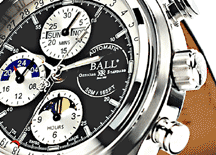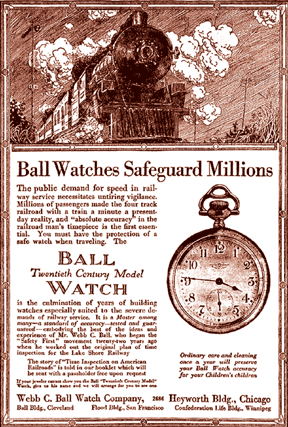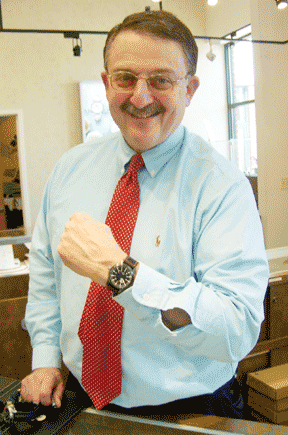Get on the Ball
We owe our punctuality to the Father of Timekeeping
by Carrie Madren, Bay Weekly staff writer
Until the late 19th century, nobody was on the ball. Before then, few people knew for sure what time it was. Countries kept their own time — or, more often, times. In the United States, 100 different time zones confounded even the most timely.
Punctuality was a virtue hard to achieve. Even appointments were hard to keep; travel could be chaotic with missed connections. Watches were put into people’s pockets in 1852, but precision remained elusive.
Railroad operators wanted their trains to run on time. For a train conductor, the time on a pocket watch was a matter of life or death.
In 1891, the industry hired Webb C. Ball to develop clocks that kept precise time, all the time. He imported Swiss watch movements and developed highly accurate pocket watches — tested and calibrated in different temperatures and conditions to meet strict standards — for railroad engineers, conductors and brakemen.
Thus America got on the ball.
“Webb C. Ball is, in a way, an unsung American hero — the father of modern, accurate timekeeping,” says Steve Hammalian, owner of Little Treasury Jewelers in Gambrills. Ball’s accurate watches kept trains running on the same time schedules — to the minute.
The phrase on the ball first referred to trains that arrived at their stops on time — to a Ball watch. Timekeeping got easier still when railroads instituted a national system of four agreed-upon time zones.
From Ball’s precise timekeeping evolved the reliable watches that get us to work on time every day.
So now we’re all on the ball.
The Test of Time
The Father of Modern Timekeeping passed away in 1922, but his watch company lives on. Ball Watch Company USA now makes wristwatches for modern punctuals. The line ranges from wristwatches classy enough for high society to watches rugged enough for diving 1,000 feet underwater.
Today’s Ball watches come with high-tech details like thermometers, dual time zone capability, diamond-like carbon coating, gun-metal blue hands, sapphire crystal and tritium-powered micro-gas capsules that act like tiny light bulbs to illuminate the watch numbers in the dark. Many come with limited edition status.
Such watches — like cars, statues, orchids or model airplanes — make for collectors’ muses.
Watch collectors come in several types, Hammalian says. One specializes in pocket watches; another seeks only old timepieces. The third pines for modern watches. In the way an auto enthusiast knows cars, these modern mavens catalogue every detail, tick and tock of their favorite watches, Hammalian says.
“With Ball watches, almost no one buys just one,” says Hammalian, who admits his own addiction — he owns eight or nine already. Last week, the jeweler wore a Ball with black leather band and orange stitching.
For collectors and connoisseurs, one of the $1,000 to $3,500 watches is not enough. They want watches with exhibition backs — clear so you can see the moving parts — and watches with commemorative art on the back. Hammalian has sold a gold Ball watch that runs upward of $7,000.
There’s even a platinum one that’s $27,000 — but Hammalian doesn’t carry it.
His business — the only store in Maryland that carries the historic line — began offering Ball watches last September and has since sold about 60, he says. He says he sees women drag their husbands into the store, where they often gravitate to the Ball watches.
“Sometimes it turns out they have multiple high-end watches,” Hammalian says — before they discover Ball. Other customers are repeat buyers.
This month, watch collectors — or anyone intrigued by history — can revel in timekeeping history at a timely tour.
 |
Steve Hammalian, owner of Little Treasury Jewelers, helped design a commemorative limited-edition B&O Railroad Ball watch.
|
All Aboard
Horophiles and history buffs can peruse Webb C. Ball’s personal collection of gold pocket watches acquired by the Ball Watch Company USA, plus more antique Ball timepieces and other watch-related items. The Ball Watch Museum Tour kicks off at the B&O Railroad Museum on May 15 and continues at Little Treasury Jewelers in Gambrills on May 16 and 17.
At the Railroad Museum, tour-goers get to see a bonus: the museum’s own historical watch collection and timepieces from National Watch and Clock Museum.
All three days, history and watch aficionados can meet Ball Watch USA president Jeffrey Hess, who’s an expert in watch history and design, and Marc Ofte, another expert.
Friday evening, at Little Treasury, stop by from 6 to 8pm for hot hors d’oeuvres, wines and international beers as you hear historic tales of timekeeping.
For the collector who has almost everything, there’s a new watch to covet: a commemorative limited-edition B&O Railroad Ball watch — which Hammalian helped design.
Ball Watch Museum Tour Reception at the B&O Railroad Museum, Baltimore on Thursday, May 15, 6-8pm includes wine and cheese as you view historical collections and hear remarks from timepiece experts. $15; rsvp: 410-752-2462 x221.
Continues Friday, May 16, 10am-8pm & Saturday May 17, 10am-4pm at Little Treasury Jewelers in the Village at Waugh Chapel, Gambrills. Friday reception 6-8pm; free; rsvp: 410-721-7100.

 Volume 16, Issue 19 - May 8 - May 14, 2008
Volume 16, Issue 19 - May 8 - May 14, 2008

